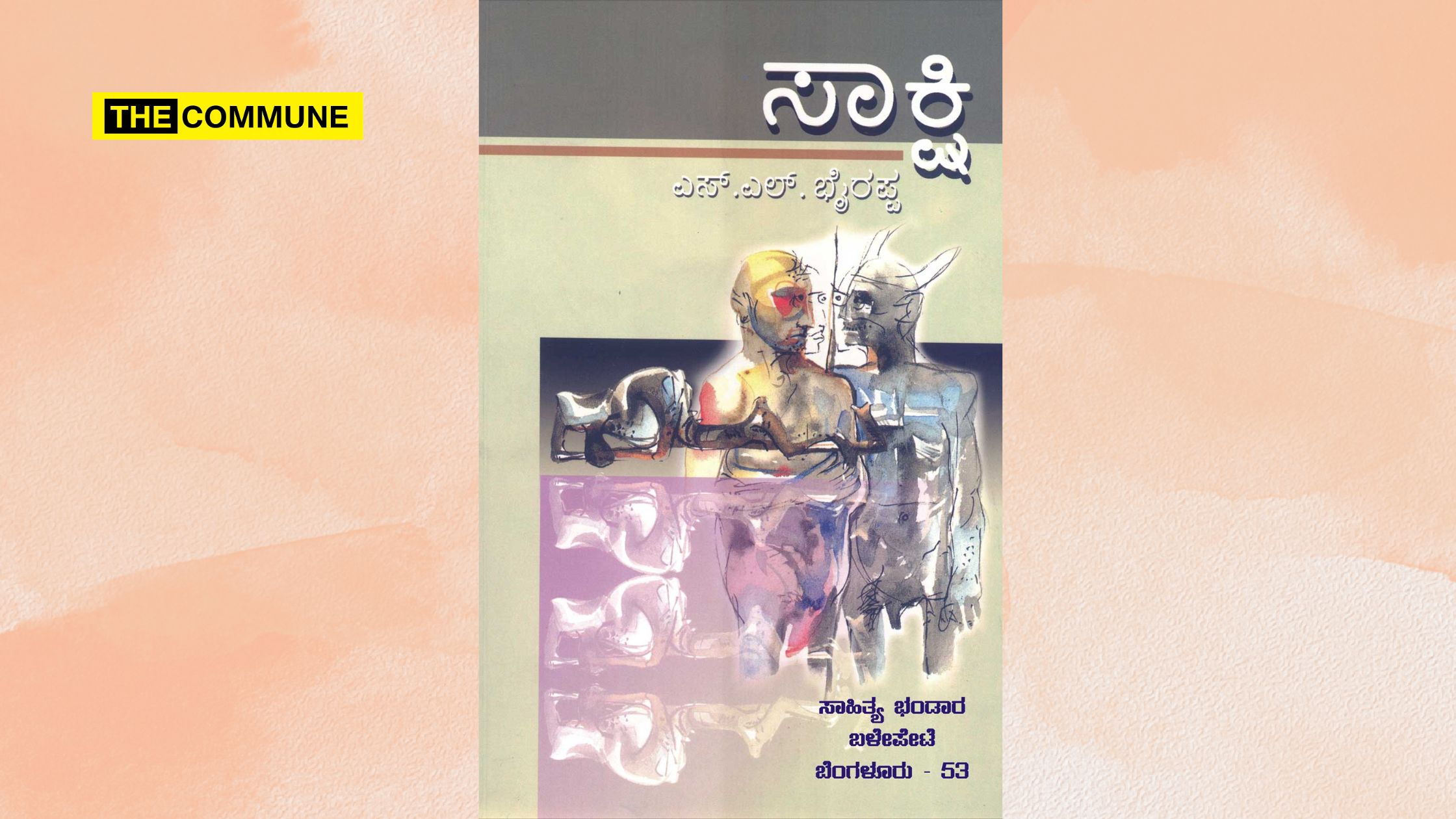
S L Bhyrappa is one of the doyens in Kannada literature whose works have found wide acclaim across a spectrum of people. His books are based on socially relevant topics with a subtle undercurrent of age-old philosophical wisdom baked into the narrative. Saakshi was initially released in Kannada in 1986, while the English translation was released in 2017. While the story of this book is set in rural Karnataka in the 1950s-60s, it is not surprising that the same is relevant today in the modern context.
In this review, I aim to delve into the metaphorical analysis of the novel and its characters and their pertinence in the modern-day context.
The story revolves around the family of Parameshwarayya of Bilikere and a certain event that triggers multiple events impacting all the stakeholders. Bhyrappa starts the book with a multi-perspective analysis of the event and its implications. The reader is masterfully transported to the individual lives of the various characters, as well as their trials and tribulations. At the same time, the story is quite complex, with multiple sub-plots and unexpected twists and turns culminating in a soul-searching question. However, when one steps back and introspects, we can decipher the thin yet strong undercurrent of Vedantic wisdom encompassing the complete narrative and the author’s brilliant attempt at communicating these nuggets through his characters’ words, actions, and thoughts.
This book encompasses the Chaturvida Purusharthas (Dharma, Artha, Kama, Moksha) as one of the arcs, while the play of shadripus (6 evils) in the daily lives of the characters provides the base on which the story is constructed. Kama, as lust/carnal desire, is a very strong character of the book. In the book, Bhyrappa provides very deep insights into the functioning of the human mind, its deep impact due to overpowering lust, and its life-altering consequences.
Parameshwarayya, who commits suicide for uttering a lie, becomes a preta and presents his case in the court of Yamadharma. Parameshwarayya represents the true manifestation of Dharma, wherein he upholds the age-old practices of his home. A person who confines himself to the cause performs true nishkama karma, i.e., action without attaching fruits to it. Parameshwarayya does have a lapse in his character when he uncharacteristically hits his daughter Savitri and the reader is left confounded by his extreme reaction. However, the final twist in the tale reveals the true reason for this extreme reaction. Despite being focused on the path of Dharma, fatherly instincts provoke him to break the fundamental laws of Dharma. Yamadharma bestows a unique boon to his preta, to be a non-judgemental and non-influential witness i.e. Saakshi to the individual experiences of the characters. In a way, the author is highlighting the fact that we need to be an impartial witness to our surroundings and understand the intricacies of life. There are multitudes of factors impacting every single event and one needs to disassociate themselves from being the centre of attention to every single event.
Ramakrishna, son of Parameshwarayya, comes across as a true successor to his father, in terms of upholding Dharma and taking the meaning of Nishakama Karma to a different plane. As a human, one of his limitations is his extreme Krodha (Anger – one of the shadripus), a fact that is reiterated multiple times across the book. However, beyond a point, he takes solace in the spirituality books, a timely reminder to the readers to consider this path as part of their lives. Ramakrishna embodies the true teachings of Gita, wherein he performs his actions, whether he likes it or not, but stays within the boundaries of Dharma. Irrespective of the treatment meted out by his own father-in-law, Nagappa who is an embodiment of Lobha (Greed), he performs his duties without any repulsion or abhorrence. While his wife Sukanya and son Ganesha are motivated towards the material benefits of life, while ignoring to perform a true self-introspection, Ramakrishna comes across as a very balanced individual maintaining his composure and his resolve to stick to Dharma. Near the conclusion, when a major earth-shattering twist is revealed about Manjayya, irrespective of his inner turmoil and perhaps the exploding anger, Ramakrishna’s resolve to perform his duties despite the revelations is truly inspirational. In a way, the author reminds the readers that life is filled with unexpected challenges, but one can still choose to be a person like Ramakrishna.
Satyappa, the son-in-law of Parameshwarayya, is a very interesting character with a very wide arc of transformation and realization. Being a Gandhian, following the teachings of Mahatma, he tries to uplift the lives of the underprivileged in his own way. Relevant social messages like Cooperation, Dairy Farming, and Sericulture are embedded into the narrative to provide a perspective of what can truly be achieved. Satyappa also realizes his limitations in influencing a wider community and realigns his goals to be more apt for his circle of influence. However, the true relevance of Satyappa lies in his inner journey and massive transformation in his character arc. A true follower of Gandhian principles, he does succumb to his subdued lust (owing to the premature death of his beloved wife) and makes a cardinal mistake. From the inner turmoil leading to an easy path of suicide to transcending that thought, embracing reality and taking a bold step to accept and make amends is truly inspirational. He represents the human of what he can become once the realization dawns upon oneself. Beyond the Gandhian that he is, he does come across as a realist in his relationship with his sister-in-law Savitri.
Savitri, the daughter of Parameshwarayya, is truly an inspirational character in the book. As a young unbridled carefree soul, she is highly opinionated and adamant on her choice of spouse. She is so blinded by Kama (Lust) that she is unable to decipher the uncharacteristic behaviour of her father. However, when realization dawns upon her, she transforms into a very strong woman who takes charge of her life. Unwilling to be a simple victim of circumstances, she starts to lead a life of her own while ensuring that she maintains her relationships and honours all her commitments towards them. Seventeen years later, when she becomes a victim of marital rape (yes, the author has brilliantly woven this concept), she undergoes a string of trials and tribulations within her own mind. Finally, she makes a series of bold decisions, some unconventional and quite contrary to modern societal concepts. If there was a character who represented Women’s Liberation, Savitri would truly be one.
Manjayya, son-in-law of Parameshwarayya and husband of Savitri, is the key central character of the book. He represents the true embodiment of uncontrolled Kama (Lust) who weaponizes the Kama and uses his charm to seduce almost every woman he comes across. He has no moral compass (until very late in the book) that allows him to lead a carefree life of his own choice. Manjayya’s actions touch the life of every character in the book irreversibly and form the crux of the narrative. Filled with Mada (arrogance) and driven by Lobha (Greed), Manjayya embodies the true manifestation of the shadripus with Kama being his weapon. However, from a metaphorical sense, Manjayya represents the Maya or the veil of the world. Manj-u in Kannada translates to Fog, a false screen that hides the reality or truth behind it. If we are enamoured by the fog and don’t strive to pursue the truth of Dharma, our own downfall is certain. The revelations at the end of the book could be repulsive, but indicative of the results for following the path of Adharma.
Lakkoo is another character, driven by lust lands up bearing the consequences of her actions (karma) in the most unfortunate manner. Her character is a timely reminder that we are responsible for our actions & results which could boomerang in the most unexpected and unfortunate manner.
Beyond these central characters, two other characters deserve a mention. Sarojakshi is another independent self-willed woman, who doesn’t shy to break the age-old norms and has a distinct personality of her own. However, her transformation from an angry wife to a submissive woman was quite unexplainable. Perhaps, she too is reflective of the scenario where Kama becomes overbearing and overpowering emotion, that subdues and masks the realities of life. Dr. Hasheem is another character who personifies Nishkama Karma, devoted to his profession despite the insults, yet has a compassionate heart and individuality that he asserts at the right time.
This book by Bhyrappa is replete with very philosophical tenets embedded in the interaction between its characters. One could consider this as a simple story, a commentary on society, or a true journey into the internal soul. We are the true Saakshi (witness) to our own self. A masterful philosophical treatise masterfully narrated by Bhyrappa, a gifted writer. A very highly recommended read.
Gee Vee is an engineer and avid fan of itihasas, puranas and books.
Subscribe to our Telegram, WhatsApp, and Instagram channels and get the best stories of the day delivered instantly.




